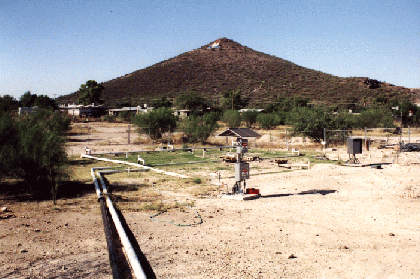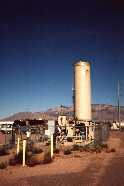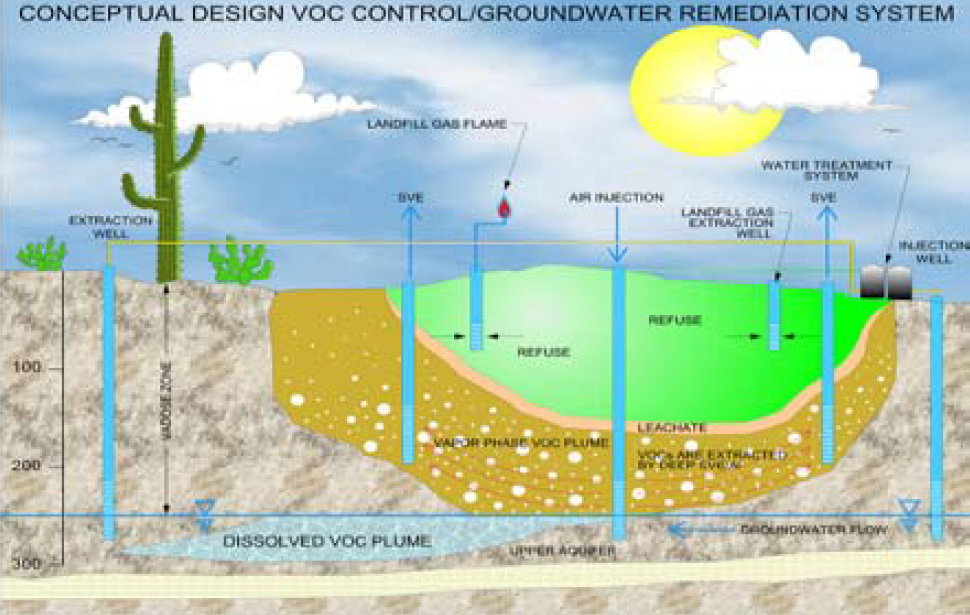|
|

Municipal
Landfills
Rio Nuevo •
Broadway North
• Harrison
•
Silverbell •
Albuquerque
•
Northwest
Tucson
Design
and Construction of Landfill Gas Control Systems
The following project descriptions present examples of HGC’s
specific experience related to LFG control systems for municipal
solid waste (MSW) landfills. Included with each project description
is a list of key responsibilities and accomplishments.
Rio Nuevo Landfill Stabilization Project
 HGC
worked on the design and testing of an in-situ enhanced
aerobic landfill stabilization system to mitigate methane generation
at three landfills that are components of a major downtown redevelopment
project. The purpose of the system was to use aerobic biodegradation
processes to accelerate decomposition of the refuse so that the
landfills no longer generate methane that would affect future
construction at the site. Preliminary project activities involved: HGC
worked on the design and testing of an in-situ enhanced
aerobic landfill stabilization system to mitigate methane generation
at three landfills that are components of a major downtown redevelopment
project. The purpose of the system was to use aerobic biodegradation
processes to accelerate decomposition of the refuse so that the
landfills no longer generate methane that would affect future
construction at the site. Preliminary project activities involved:
• review and interpretation of existing data on landfill
characteristics and methane distribution,
• design of an aerobic stabilization pilot study
• installation of LFG monitoring, extraction, and air injection
wells,
• refuse characterization,
• air permeability testing and in-situ methane generation
rate testing, and
• numerical modeling of the aerobic stabilization process.
More
information
In the News •
Solid Waste News Article
• Brownfields Bulletin
Article • Inside
Tucson Business Article •
APWA
Award •
City
of Tucson Environmental Management Department
•
Rio
Nuevo Project •
back
to top
Albuquerque,
New Mexico Landfill
 Hydro
Geo Chem designed and oversaw construction
of a deep LFG control system, and modify the existing shallow
LFG control system at this closed MSW landfill. The landfill is
suspected of generating methane that is moving off site, under
an adjacent business park. The landfill is also the suspected
source of a large area of halogenated VOC contamination in groundwater
beneath the site. HGC was retained to: Hydro
Geo Chem designed and oversaw construction
of a deep LFG control system, and modify the existing shallow
LFG control system at this closed MSW landfill. The landfill is
suspected of generating methane that is moving off site, under
an adjacent business park. The landfill is also the suspected
source of a large area of halogenated VOC contamination in groundwater
beneath the site. HGC was retained to:
• conduct soil and LFG sampling to determine the extent of
HVOC contamination,
• perform pneumatic and pressure drawdown tests to determine
vertical and horizontal air permeabilities and in-situ LFG generation
rates,
• develop conceptual design for LFG/VOC control system,
• develop engineering design, and
• oversee construction and operation.
Field work and design development are ongoing at the landfill.
More
information
City
of Albuquerque Solid Waste Management •
Albuquerque Journal Article
•
back
to top
Harrison
Landfill
 This
recently closed MSW landfill was suspected of generating
methane that was moving off site onto adjacent private
property and was the subject of litigation. In addition,
the landfill was suspected to be a source of volatile
organic compounds (VOCs). HGC was retained to: This
recently closed MSW landfill was suspected of generating
methane that was moving off site onto adjacent private
property and was the subject of litigation. In addition,
the landfill was suspected to be a source of volatile
organic compounds (VOCs). HGC was retained to:
• conduct soil gas surveys to determine the extent
of methane migration and VOC distribution,
• conduct soil and refuse characterizations to
determine refuse biodegradability and LFG generation
potential,
•
perform barometric pressure tests to estimate in-situ
LFG generation rates,
• conduct pressure testing of the existing LFG
collection system to evaluate its performance,
• obtain air quality permits, and
• design, construct, and operate an LFG/VOC control
system that will work in conjunction with the LFG collection
system and remove VOCs.
The LFG/VOC control system that HGC constructed has
been operating since August 1999, and has removed over
14,000 pounds of contaminants from the subsurface. LFG
migration is well under control.
More
information
APWA
Projcet of the Year Award
• Arizona Daily
Star Article •
APWA
Reporter Article •
City
of Tucson Environmental Management Department
•
back
to top
Silverbell
and Broadway Landfills
 Both
MSW landfills are closed and unlined landfills and were
suspected of generating methane and odors that were
moving off the site onto adjacent private properties.
In addition, both landfills were suspected to be sources
of VOCs to groundwater. HGC was retained to: Both
MSW landfills are closed and unlined landfills and were
suspected of generating methane and odors that were
moving off the site onto adjacent private properties.
In addition, both landfills were suspected to be sources
of VOCs to groundwater. HGC was retained to:
• conduct an LFG survey to determine the extent
of the off-site methane migration and VOC distribution,
• conduct refuse characterization to determine
refuse biodegradability,
• perform barometric pressure and drawdown tests
to determine vertical and horizontal air permeabilities
and in- situ LFG generation rates,
• obtain air quality permits,
• develop an engineering design with extraction
rates of 1,500 scfm, and
• complete construction and operation.
The LFG/VOC control system that HGC constructed has
been operating since June 2000 for the central city
landfill, and February 2001 for the west side landfill.
LFG and odor at both sites have been sucessfully controlled.
More
information
City
of Tucson Environmental Management Department
•
AZ Daily Star Article 12-30-02
•
back
to top
Landfill Gas Measurement and Control at
Northwest Tucson Landfill, Arizona
A
landfill gas control system was already in place at
the site, but the available LFG was insufficient to
operate the flare. The landfill was also suspected to
be a source of VOCs in groundwater. HGC was retained
to:
•
Perform baro-pneumatic tests to measure in-situ LFG
generation rates and permeability distribution
• Construct an LFG/VOC control system consisting
of gas-extraction and air injection wells
HGC’s
estimate of LFG generation was one-third to one tenth
of previously obtained estimates, consistent with the
low production obtained by the existing oversized LFG
collection system. HGC’s LFG/VOC control system
is now in place.
back
to top
Design
of Alternative Cover, Closed Solid Waste Landfill
Former Superfund site, California
Hydro Geo Chem designed an alternative soil cover for
a closed solid waste landfill that was part of a former
Superfund site in northern California. This landfill
is part of a Federal Superfund site that had been used
for the disposal of municipal and industrial solid waste
for over 50 years. HGC evaluated the thickness, soil
water properties, and drainage requirements for the
cover to prevent infiltration of rainwater into the
underlying refuse. This work was performed to meet the
cover requirements of the California Integrated Waste
Management Board. This work involved:
• soil gas surveys to determine the extent of methane
migration,
• drilling and sampling of the refuse,
• in-situ measurements of methane generation rates,
• evaluation of remedial alternatives including
methane control systems, and
• design of a landfill cover and drainage that
met State of California standards.
Earthen
Cover Design •
back to top
HYDRO GEO CHEM, INC.
51
West Wetmore Road, Suite 101, Tucson, Arizona 85705-1678
Toll Free (800) 727-5547,
Tel. (520) 293-1500, Fax (520) 293-1550, Email
contact@hgcinc.com
13422 North Cave Creek Road, Suite 7, Phoenix, Arizona 85022
Tel.
(480) 421-1501, Fax (480) 425-8794
Hydro
Geo Chem, Inc. assumes no responsibility for the consequences of reliance
by others on the
information provided on this web site
Copyright
© 2025 - by Hydro Geo Chem, Inc., all rights reserved
|

 HGC
worked on the design and testing of an in-situ enhanced
aerobic landfill stabilization system to mitigate methane generation
at three landfills that are components of a major downtown redevelopment
project. The purpose of the system was to use aerobic biodegradation
processes to accelerate decomposition of the refuse so that the
landfills no longer generate methane that would affect future
construction at the site. Preliminary project activities involved:
HGC
worked on the design and testing of an in-situ enhanced
aerobic landfill stabilization system to mitigate methane generation
at three landfills that are components of a major downtown redevelopment
project. The purpose of the system was to use aerobic biodegradation
processes to accelerate decomposition of the refuse so that the
landfills no longer generate methane that would affect future
construction at the site. Preliminary project activities involved:
 Hydro
Geo Chem designed and oversaw construction
of a deep LFG control system, and modify the existing shallow
LFG control system at this closed MSW landfill. The landfill is
suspected of generating methane that is moving off site, under
an adjacent business park. The landfill is also the suspected
source of a large area of halogenated VOC contamination in groundwater
beneath the site. HGC was retained to:
Hydro
Geo Chem designed and oversaw construction
of a deep LFG control system, and modify the existing shallow
LFG control system at this closed MSW landfill. The landfill is
suspected of generating methane that is moving off site, under
an adjacent business park. The landfill is also the suspected
source of a large area of halogenated VOC contamination in groundwater
beneath the site. HGC was retained to:
 Both
MSW landfills are closed and unlined landfills and were
suspected of generating methane and odors that were
moving off the site onto adjacent private properties.
In addition, both landfills were suspected to be sources
of VOCs to groundwater. HGC was retained to:
Both
MSW landfills are closed and unlined landfills and were
suspected of generating methane and odors that were
moving off the site onto adjacent private properties.
In addition, both landfills were suspected to be sources
of VOCs to groundwater. HGC was retained to: